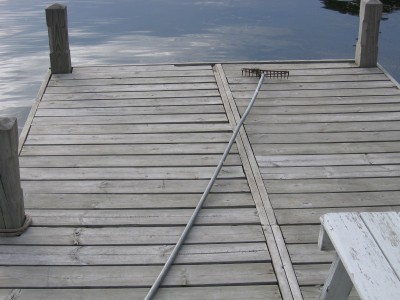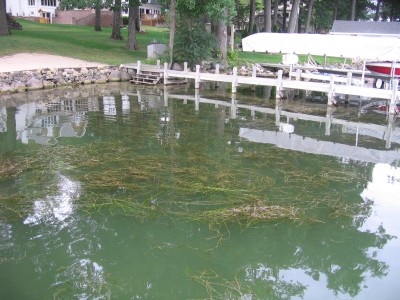The Sanitary District tries to cut as close to the end of the piers as possible when harvesting. We do not cut between piers in the near-shore areas. We do provide clean-up services (orange machines) in accessible shore areas. These machines do not have the ability to cut plants. They only remove floating material or that which has been stacked up by the home-owner. We also provide pile pick-up for those people that clean their own area and stack material where it is accessible to our transport barges. This service is provided on Mondays and Fridays.
The District encourages homeowners that wish to maintain their near shore areas to use non-chemical maintenance techniques. Manual removal of both native and non-native plant species by a riparian owner is allowed by the Department of Natural Resources (see NR 109) for up to 30 feet of shoreline without a permit. Non-native invasive species, such as Eurasian water milfoil and curly leaf pondweed, may be removed beyond the 30 foot limit. All plant material that is cut must be removed from the lake.
The Tools
The tools we are showing are the ones that seem to be the most popular and are not an endorsement of any particular brand or type. A web search for aquatic plant removal tools will provide multiple sites with equipment for sale. We do list some of the local suppliers of tools in our area on this site.

Figure 1
The V cutter shown in Figure 1 is very popular with our lake residents. It is razor sharp and needs to be stored and used with caution. It will cut about 4 feet wide and may be thrown out about 25 feet.

Figure 2
The floating weed rake shown in Figure 2 is used to remove the floating plant material after the use of the weed cutter. It is also useful after a weekend of heavy boat traffic to remove the material cut by props. The one shown is homemade and will clear about 4 feet in a pass. As with the cutter there are various models available commercially.

Figure 3
The rake shown in Figure 3 is used to clean up light weight floating material. It is also very effective for cleaning material from beach areas and between stones. This model is lightweight with flexible tines and is extremely durable. Our shore crews use this model.

Figure 4
The final tools are the old standby pitch fork (not shown) and the metal garden type rake. Both tools are used to stack up weeds on the shore. The rake shown in Figure 4 has a ten foot length of ¾-inch conduit welded on for a handle. This length makes it very useful for pulling out growing plants next to the pier.
How to Use the Tools

Throw

Retrieve
Before and After Pictures

Before

After







